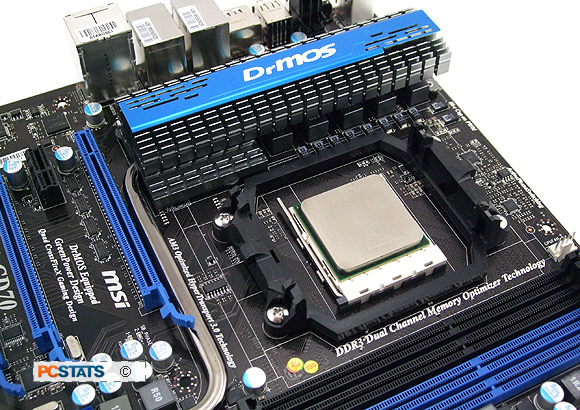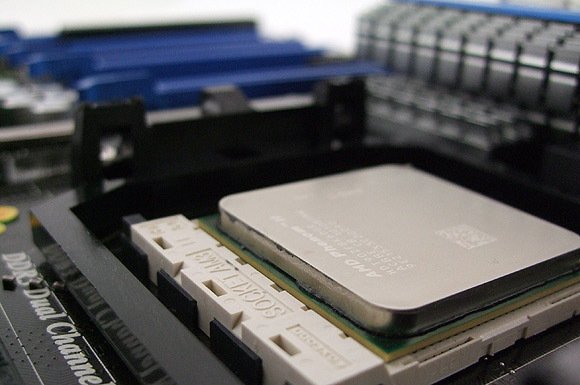 |
| Overclocking Results |
|
|
PCSTATS
has overclocked a great many single core AMD processors, and within the last
couple years everything from dual-core to triple-core, right on through to
quad-core chips. Those experiences have shown us that it's not too difficult to
overclock an AMD chip to within 4.0GHz... it's getting past that hurdle into
4.2GHz territory where significant challenges
remain.
Of all the AMD CPUs we've tested for our readers,
overclocking AMD's Black Edition processors has
been the most fun.
Because Black Edition chips ship multiplier
unlocked, the clock speed of the processor can be increased by adjusting the
clock multiplier alone while bus speeds are left at or near 200MHz. Bus
speeds tend to be a limiting factor on most motherboards, so overclocking via
multiplier adjustments brings about a flexibility that's otherwise absent from
mainstream CPUs families.
In the case of the Phenom II X6 1090T processor
we're testing in this review, the TurboCore feature boosts core speed to 3.6GHz
when 1-to-3 cores are fully loaded. Bus speed remains at 200MHz when this
occurs, so for TurboCore to function AMD had to leave the CPU multipler
unlocked. Yet AMD doesn't advertise this fact by tacking a "Black Edition"
moniker after the 1090T model number. This decision will likely lead to
confusion later on as AMD reps PCSTATS spoke with have indicated the company
will introduce future TurboCore processors under the Black Edition
branding.
To
address any lingering questions, the AMD Phenom II X6 1090T processor that
PCSTATS tested for this review was fully multiplier unlocked.... we're just
not entirely sure if it's a AMD Phenom II X6 1090T or AMD Phenom II X6
1090T Black Edition processor. AMD was less than specific
when pressed for a clarification. The default 16x multiplier couldn't be set as
high as 31.5x, though in our overclocking tests the best workable setting we
managed was 2/3rds that high.

Pre-Overclocking
Warm up
Before
overclocking began the Corsair
CM3X2G1600C9DHX memory was set to run in
DDR3-800 MHz mode from its default of DDR3-1033. For the best overclocking
results you need high quality memory - Corsair's DDR3 RAM has been a part of the PCSTATS CPU
test platform years because it's fast and takes to overclocking like a champ. Dropping the memory speed
helps ensure the RAM won't be holding the CPU back as bus speeds increase. The
standard AMD reference AVC Z7U7414001 heatsink was used for cooling. For the
latest and greatest cooling solutions have a look at PCSTATS' sister website, Frostytech.com.

Overclocking 3.2-to-3.9GHz!
The 6-core
AMD Phenom II X6 1090T has a default 16x multiplier for an overall clock speed of
16x 200MHz = 3.2GHz. That's pretty fast, but with
TurboCore three of the six cores will automatically overclock to 18x 200MHz =
3.6GHz when certain load situations occur.
So really, you don't need to do anything - the PII X6
1090T overclocks itself from the get go when the CPU-load demands!
.... but what fun is that? Okay, let's getting down to
business.
The multiplier on the AMD Phenom II X6 1090T was
overclockable from 16x as far as 20x without any POST issues, but at
20x the test computer BSOD'd while loading Windows. In the end PCSTATS had
to settle for a maximum multiplier overclock of 19.5x which
resulted in a clock speed of 3.9GHz. At this speed WPrime will complete it's calculations in 7.113 seconds, SuperPi
to 8M in a time of 3:49.836!
With the CPU multiplier rolled back to 16x, PCSTATS set
out to overclock the Phenom II X6 1090T by bus speed alone. Starting from
200MHz, the bus speed was rapidly increased to 223MHz, 231MHz... 240... and
245MHz before the computer crashed with a dull thud. After some fiddling,
PCSTATS settled on a moderate overclock of to the bus speed of
240Hz, resulting in a processor clock speed overclock to
3.84GHz.
Bus + Multiplier Overclocking
For the final
round of overclocking fun the bus speed was reset to 200MHz and CPU multiplier
back down to 16x, then both were slowly increased towards the established
maximums (multiplier 19.5x and Bus 240MHz). It didn't take very long before
Phenom II X6 1090T processor was running on a 225MHz Bus and 17.5x
multiplier, for a maximum CPU overclock to 4.025 GHz.
Overclocking milage always varies, but for a 6-core processor PCSTATS is
pretty happy with the results we've seen here.
Next up, PCSTATS has several round of benchmarks to test the Phenom II X6's
multi-threading capabilities and how it stacks up against dual, triple and
quad-core CPUs!

